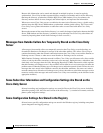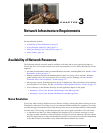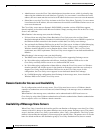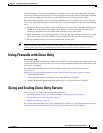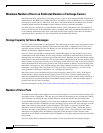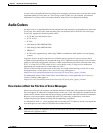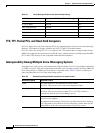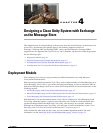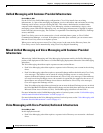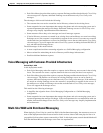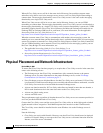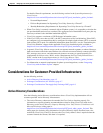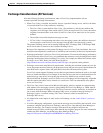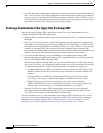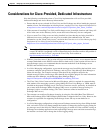
4-2
Design Guide for Cisco Unity Release 5.x
OL-14619-01
Chapter 4 Designing a Cisco Unity System with Exchange as the Message Store
Deployment Models
Unified Messaging with Customer-Provided Infrastructure
Revised May 6, 2008
For the Cisco Unity Unified Messaging configurations, Cisco Unity installs into an existing
infrastructure, is a part of the messaging environment, services subscribers who are homed on existing
Exchange e-mail servers, and uses existing DC/GCs. This reduces administrative overhead when
compared with maintaining a Cisco
Unity Voice Messaging solution or maintaining a legacy voice
messaging system. With Unified Messaging, only one messaging infrastructure is required to support
both e-mail and voice messaging. The customer is responsible for maintaining the DC/GCs, Exchange
servers, and DNS.
Each Cisco Unity server can be connected to a circuit-switched phone system, to Cisco Unified
Communications Manager, or to both. If the phone system has ports available, you can connect more
than one Cisco
Unity server to each phone system.
When you are setting up two or more Cisco Unity servers in the same Active Directory forest, the
Cisco
Unity servers can be networked by using Cisco Unity Digital Networking.
Mixed Unified Messaging and Voice Messaging with Customer-Provided
Infrastructure
When mixing Unified Messaging and Voice Messaging deployment models, the Unified Messaging
portion of the deployment is the same as a Unified Messaging deployment without the Voice Messaging
subscribers.
The Voice Messaging subscribers require separate accounts and mailboxes:
• Each Voice Messaging subscriber requires a separate Active Directory user account in the existing
forest.
• Each Voice Messaging subscriber requires a separate Exchange mailbox that holds only Cisco Unity
voice messages. The mailbox can be stored on existing Exchange servers or can be stored on
separate, dedicated Exchange servers that home only Cisco
Unity voice messages. If the mailboxes
are stored on existing Exchange servers, the customer is responsible for support for the servers. If
the mailboxes are stored on Exchange servers that are dedicated to Cisco
Unity voice messages,
Cisco will support the Exchange servers.
If the Voice Messaging subscribers are homed on one or more dedicated Exchange servers on which
the Voice Mail Run-time Edition of Microsoft Exchange was installed, those subscribers do not need
Microsoft Client Access Licenses (CALs). Unified Messaging subscribers all need CALs.
For more information on the Unified Messaging portion of a mixed system, see the “Unified Messaging
with Customer-Provided Infrastructure” section on page 4-2.
For more information on the Voice Messaging portion of a mixed system, see the “Voice Messaging with
Customer-Provided Infrastructure” section on page 4-3.
Voice Messaging with Cisco-Provided, Dedicated Infrastructure
Revised May 6, 2008
In this deployment model:
• Each Voice Messaging subscriber requires a separate Active Directory user account in a dedicated
forest.



